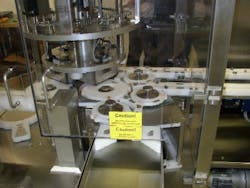Wyeth Carolina Uses PAT to Monitor an Oxygen-Sensitive New Parenteral
Dec. 20, 2005
One of our key products at Wyeth Carolina is a new parenteral that is highly sensitive to oxygen and can degrade from continued exposure. During manufacture, great care must be taken to prevent oxygen ingress. Thus, for example, the lyophilized product is sealed under partial vacuum in a nitrogen atmosphere. During the vacuum break cycle, nitrogen is back-flushed into the lyophilization chamber to 860 mb pressure and the stopper is then set.Last year, our team saw an opportunity to use Process Analytical Technology (PAT) to expand our capabilities to monitor oxygen with this product. PATs overall goal, as defined by FDA, is to design, analyze and control manufacturing by measuring critical quality and performance attributes during manufacturing. If designed right, a PAT application would allow us to monitor and control a critical product attribute and ensure the safety and efficacy of the drug from manufacture through distribution and sale.There are many possible ways that air can enter a vial before sealing or capping. A stopper can stick to the lyophilizer shelf (due to shelf finish, defective stoppers, stopper siliconization, or defective stopper finish material) and become unseated when the shelf rises, or it can become partially dislodged during manual transfer from the lyophilizer to the sealing area. The vial can be defective, cracked, or out of specification.Air ingress can increase headspace pressure in the vial by up to 1 atmosphere, causing oxygen content in the product to increase to 3%, well above acceptable levels. (The pressure value reference used is 1,013 mb at sea level. The 3% value is based on available headspace volume and ingress of 173 mbar of air.) To prevent this from occurring, we needed some way to monitor oxygen levels within the vial headspace. A non-destructive technologyThe traditional method of doing this is through a destructive laboratory analysis involving gas chromatography. Since we had used this test successfully for batch release and it met all component testing requirements, we had no intention of replacing it. However, we knew that we needed a technology to support our oxygen monitoring efforts. Other technologies were available, but each had its own limitations:
- Dye-leak tests are not suitable for 100% in-line inspection.
- Pressure decay tests offer a leak detection limit of less than 5 microns.
- Pressure decay, dye leak and helium tests require that the container leak at time of measurement.
- Spark tests might impact product.
- Moisture/pressure tests may prove inaccurate since moisture amounts can vary between lots.
- We wanted to inspect the product as late as possible in the process, so that we could maximize inspection opportunities and remove any defects that might be introduced during the sealing process (e.g., cracks under the seal finish);
- Space was limited in the sealing area, so there wasnt enough room to allow a complete cosmetic and oxygen content inspection to be performed.
- FDA Guideline. General Principles of Process Validation, May 1987.
- FDA Guideline. Container and Closure Integrity Testing in Lieu of Sterility Testing as a Component of the Stability Protocol for Sterile Products, March 18, 2003.
- FDA Guidance for Industry. Container Closure Systems for Packaging Human Drugs and Biologics, May 1999.
- FDA Guidance for Industry. Sterile Drug Products Produced by Aseptic Processing Current Good Manufacturing Practice, September 2004.
- FDA Guide to Inspections of Lyophilization of Parenterals, July 1993.
- FDA Guide to Inspections of Sterile Drug Substance Manufacturers, July 1994.
- FDA Guidance for Industry, PAT A Framework for Innovative Pharmaceutical Development, Manufacturing, and Quality Assurance, September 2004.
John Walsh is a Technology Manager, Global Technology, for Wyeth in Collegeville, Pa., supporting new technologies and validation applications at various manufacturing sites. He has been with Wyeth for over 15 years.Dave Bertsch is a Principal Equipment Engineer at Wyeth corporate headquarters, supporting manufacturing and packaging sites on technical equipment applications. He has been with Wyeth for 27 years.Vivianne Colón is a Technology Scientist at Wyeth Carolina, Puerto Rico, currently working in the support of technology development projects which include the transfer of products, processes, and equipment technology for parenteral products. She has been with Wyeth for four years.
Latest from Automation & Control
Latest from Automation & Control








